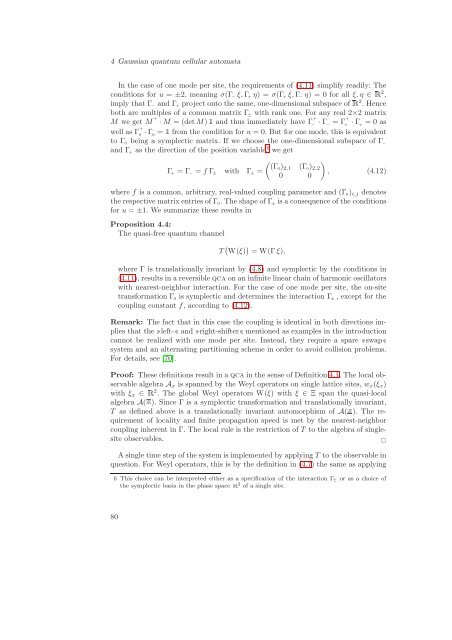Quantum Information Theory with Gaussian Systems
Quantum Information Theory with Gaussian Systems
Quantum Information Theory with Gaussian Systems
You also want an ePaper? Increase the reach of your titles
YUMPU automatically turns print PDFs into web optimized ePapers that Google loves.
4 <strong>Gaussian</strong> quantum cellular automata<br />
In the case of one mode per site, the requirements of (4.11) simplify readily: The<br />
conditions for u = ±2, meaning σ(Γ − ξ, Γ + η) = σ(Γ + ξ, Γ − η) = 0 for all ξ, η ∈Ê2 ,<br />
imply that Γ − and Γ + project onto the same, one-dimensional subspace ofÊ2 . Hence<br />
both are multiples of a common matrix Γ ± <strong>with</strong> rank one. For any real 2×2 matrix<br />
M we get M +<br />
· M = (det M) and thus immediately have Γ +<br />
= 0 as<br />
− · Γ = Γ+<br />
− + · Γ +<br />
well as Γ +<br />
0 ·Γ0 = from the condition for u = 0. But for one mode, this is equivalent<br />
to Γ0 being a symplectic matrix. If we choose the one-dimensional subspace of Γ− and Γ + as the direction of the position variable, 6 we get<br />
Γ + = Γ − = f Γ ±<br />
<strong>with</strong> Γ ± =<br />
(Γ0)2,1 (Γ 0)2,2<br />
0 0<br />
<br />
, (4.12)<br />
where f is a common, arbitrary, real-valued coupling parameter and (Γ 0)i,j denotes<br />
the respective matrix entries of Γ 0. The shape of Γ ± is a consequence of the conditions<br />
for u = ±1. We summarize these results in<br />
Proposition 4.4:<br />
The quasi-free quantum channel<br />
T W(ξ) = W(Γ ξ),<br />
where Γ is translationally invariant by (4.8) and symplectic by the conditions in<br />
(4.11), results in a reversible qca on an infinite linear chain of harmonic oscillators<br />
<strong>with</strong> nearest-neighbor interaction. For the case of one mode per site, the on-site<br />
transformation Γ 0 is symplectic and determines the interaction Γ ± , except for the<br />
coupling constant f, according to (4.12).<br />
Remark: The fact that in this case the coupling is identical in both directions implies<br />
that theleft-andright-shiftermentioned as examples in the introduction<br />
cannot be realized <strong>with</strong> one mode per site. Instead, they require a spareswap<br />
system and an alternating partitioning scheme in order to avoid collision problems.<br />
For details, see [70].<br />
Proof: These definitions result in a qca in the sense of Definition 4.1. The local observable<br />
algebra Ax is spanned by the Weyl operators on single lattice sites, wx(ξx)<br />
<strong>with</strong> ξx ∈Ê2 . The global Weyl operators W(ξ) <strong>with</strong> ξ ∈ Ξ span the quasi-local<br />
algebra A(). Since Γ is a symplectic transformation and translationally invariant,<br />
T as defined above is a translationally invariant automorphism of A(). The requirement<br />
of locality and finite propagation speed is met by the nearest-neighbor<br />
coupling inherent in Γ. The local rule is the restriction of T to the algebra of singlesite<br />
observables. <br />
A single time step of the system is implemented by applying T to the observable in<br />
question. For Weyl operators, this is by the definition in (4.7) the same as applying<br />
6 This choice can be interpreted either as a specification of the interaction Γ± or as a choice of<br />
the symplectic basis in the phase spaceÊ2 of a single site.<br />
80
















